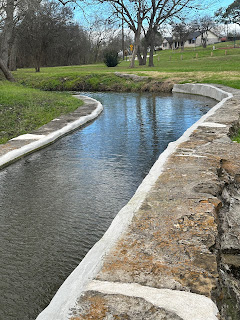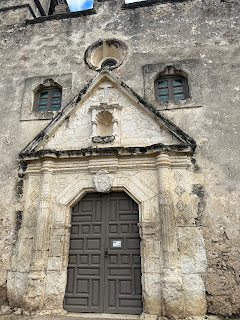Missions of San Antonio
In the 17th century, Spain maintained evangelizing missions throughout its colonies of New Spain (Mexico and southwestern United States). Spanish missions in Texas or Tejas, established mainly by Franciscan priests, spread the Christian Gospel among Native Americans and gave the Spanish crown a jumping off point to expand its overseas territories.
Missions were first built in eastern Texas as a response to raids by 17th-century French explorer Sieur de La Salle followed by the first French outposts along the Gulf Coast and were meant to serve as a buffer against French incursions from Louisiana into Spanish territory. The Sabine River flowing north-south into the Gulf of Mexico became a border between French and Spanish colonies (as it is today between Louisiana and Texas) with Spanish missions moving west to San Antonio when threatened by indigenous tribes.
Resembling Village Life in Spain
The aim of the Missions was to make a life that would resemble village life in Spain. Native Americans were introduced to animal husbandry, grist mills, fruit and vegetable cultivation, in addition to ploughing, weaving, tailoring, carpentry, and masonry. And, most importantly, they were taught Spanish, Latin, and Christianity. The ultimate objective was to convert indigenous hunter-gatherer folk into Catholic, tax-paying subjects of the King of Spain — in this goal, they certainly failed!
In their heyday, Missions were self-sustaining communities that traded with their neighbors. Within the compounds, artisans produced cloth, hides, and iron tools. Outside the walls, melons, pumpkins, grapes, and peppers were grown in orchards, while farmers cultivated corn, squash, sweet potatoes, beans, and sugar cane in irrigated fields. Others reared sheep and cattle.
There is little historical evidence of large scale resistance to Mission life by Native populations. Their previous hard scrabble existence would have improved and Mission compounds would have offered protection from raiding Apaches and Comanches.
Missions: Concepción, San Jose, San Juan, and Espada
In all, 26 missions were maintained for different lengths of time. Today four remain in San Antonio: Mission Concepción, Mission San Jose, Mission San Juan, and Mission Espada. With the exception of San Jose, the others were established in 1731.
San Jose, known as the Queen of the Missions, is the most complete and reconstructed. Remains of the historic convento or friary, grist mill, granary, soldiers’ quarters, family housing and more, can be seen. It is also the oldest Mission, established in 1720.
Mission Concepción is the oldest unrestored stone church in America. Its structure and architectural features are original. It has a fresco showing a drawing of the sun, meaningful to Native Americans. This fresco may have served as a precursor to more Christianized iconography and symbols.
Mission San Juan, in the mid-1700s, was a regional supplier of agricultural produce with its rich farm and pasture lands. It established a trade network stretching east to Louisiana and south to Coahuila, Mexico. It’s thriving economy safeguarded it against attacks in its final years.
Mission Espada is famous for an aqueduct constructed by the Franciscans in 1745. It brought water to farmlands traveling in an acequia (irrigation system) from the San Antonio River over a low elevation creek, to maintain the elevation and potential energy of the water.
Secularization
Communities were expected to reach a point of maturity when no special Mission status was needed and they could transition into colonial society. This transition was called "secularization." It meant that the Mission’s communal properties and land were transferred to Native people, while religious duties were transferred to the diocesan church. Most Missions became secularized in the last decades of the 18th century.
Failure of the Mission System
The Mission system was developed in the first place to avoid placing control of Native American populations in the hands of civilians and soldiers which had resulted too often in starvation, abuse, and enslavement of indigenous people.
The Missions were comparatively successful for 80 years — until authorities in Spain pulled their funding. Their earlier success could be attributed to the fact that there was not one tribe to deal with but many tribes, all reckoning with a powerful common enemy, Lipan Apaches and Comanches — who raided from time to time looking for grain and horses.
In the end, the Mission system was not politically or socially sustainable or strong enough to protect Native Americans against the growing power of ranchers and other business interests that sought control over Mission lands. By 1850, all Missions still operating in Texas were officially secularized.
Perhaps the only reason that indigenous people in Texas largely escaped officially sponsored genocide by Anglo-American settlers (suffered by their brethren in California) was because there was no discovery of gold — as there was in California.
Spanish Legacy
Despite the limited nature of Spanish colonization in North America, its influence in Texas remains extensive. Many counties in southern and western Texas have majority Spanish-speaking populations. Cities and rivers have Spanish names and Spanish architectural concepts flourish.
Early Spanish farmers who tilled and irrigated the land, changed the landscape. Grazing of European livestock caused mesquite trees to spread inland, replacing native grassland. European diseases brought by the Spanish decimated Native American people, leaving a population vacuum filled by Anglo American settlers.
Mission farming relied on gravity-powered acequia or irrigation systems that used dams, aqueducts, and ditches to divert water from the San Antonio River to the fields. The Espada Aqueduct is the only remaining Spanish aqueduct in the U.S. and is still in use! It is one of the more enduring legacies of Spanish rule.
Coahuiltecan
The people who lived on the Missions were known as Coahuiltecan. The term is derived from an Aztec or Nahuatl word and was the collective name that Spanish colonists gave to the various hunter-gatherer tribes in Texas and northeastern Mexico.
The Coahuiltecan were small autonomous bands of indigenous people who inhabited the Rio Grande valley. First encountered by Europeans in the 16th century, their population dwindled rapidly as a result of disease, slavery, and wars.
Mestizo
Missions were guarded by Spanish soldiers whose relationships with indigenous women led to the creation of a new ethnic group, the Mestizo, who spoke Spanish, were staunchly Catholic, and remain so to this day. While they say they are saddened that their languages and culture were obliterated, they are happy to have inherited vocational skills from their forefathers who lived on the Missions and to have an identity that straddles both cultures.
Many San Antonio residents trace their family heritage to these Missions. My guide, Matt, who claimed to be Mestizo on both sides of his family, told me that indigenous people have straight hair on their heads and no facial hair. According to him, his own moustache and slightly wavy hair were proof of his mixed ancestry!
The term Mestizo is not used for official purposes. Hispanic Americans are classified by language rather than ethnicity.
Sunday worship continues at all four Missions. According to Matt, services are popular and crowded and it’s always a challenge to find parking.
Gente de Razón
Gente de Razón (people of reason" or "rational people") was a term used by Spain in its colonies to refer to people who were culturally Hispanicized, that is, they had accepted Spanish rule and Christianity. It referred to indigenous people who maintained their culture and lived in their legally recognized communities as well as mixed-race people (castas). The poor in urban centers who clung to indigenous beliefs were considered not to be gente de razón; that is, they were gente sin razón (people without reason)!
It is a term one hears a lot of while visiting the Missions. The people who still live in the area are proud to be gente de razón, proof that Spanish colonial legacy (however outmoded) still lives on!
Ludi Joseph
San Antonio, TX
February 6, 2024
 |
Espada Aqueduct |
 |
Mission Espada |
 |
Espada Chapel |
 |
Mission San Juan |
 |
Mesquite Tree with Ball Moss |
 |
Mission San Jose |
 |
Mission Concepcion |
 |
Rose Window, Mission Concepcion |
 |
Chapel, Mission Concepcion |
 |
Sun Fresco, Indigenous Symbol |
 |
Church Door, Mission Concepcion |
Videos:
Espada Chapel
Espada Aqueduct












